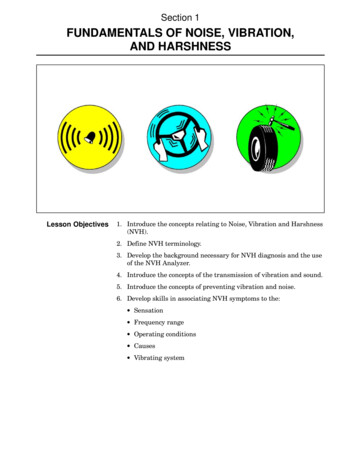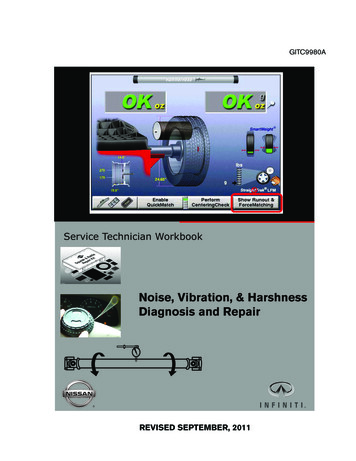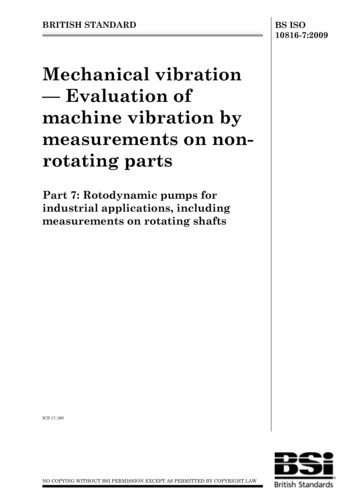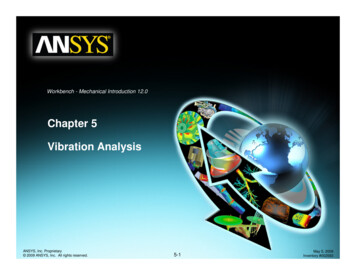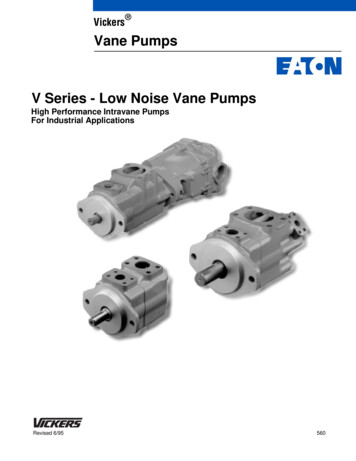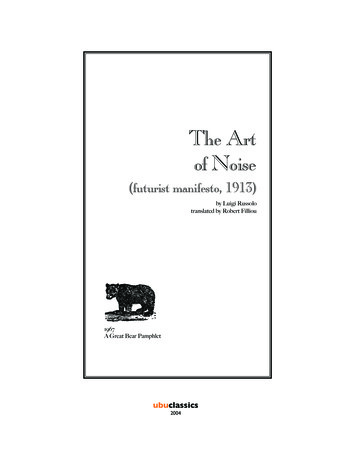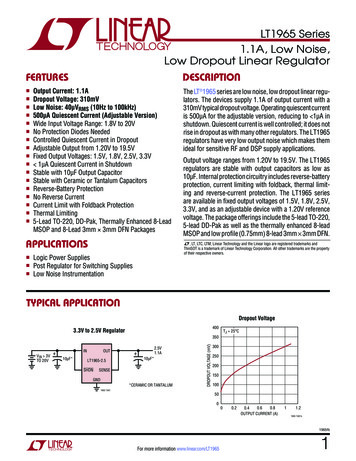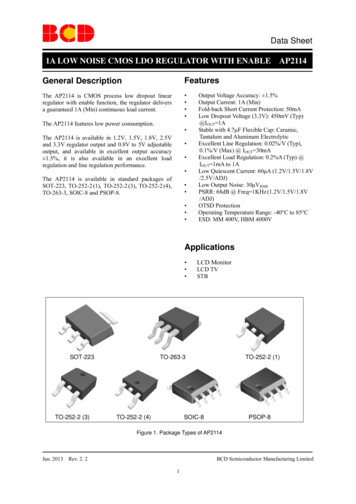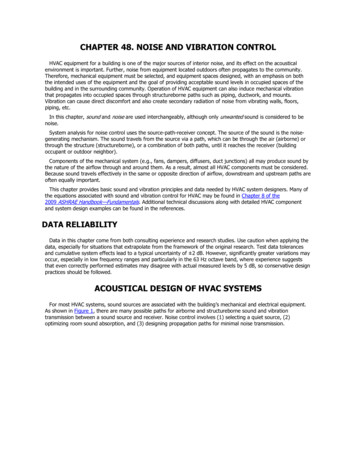
Transcription
CHAPTER 48. NOISE AND VIBRATION CONTROLHVAC equipment for a building is one of the major sources of interior noise, and its effect on the acousticalenvironment is important. Further, noise from equipment located outdoors often propagates to the community.Therefore, mechanical equipment must be selected, and equipment spaces designed, with an emphasis on boththe intended uses of the equipment and the goal of providing acceptable sound levels in occupied spaces of thebuilding and in the surrounding community. Operation of HVAC equipment can also induce mechanical vibrationthat propagates into occupied spaces through structureborne paths such as piping, ductwork, and mounts.Vibration can cause direct discomfort and also create secondary radiation of noise from vibrating walls, floors,piping, etc.In this chapter, sound and noise are used interchangeably, although only unwanted sound is considered to benoise.System analysis for noise control uses the source-path-receiver concept. The source of the sound is the noisegenerating mechanism. The sound travels from the source via a path, which can be through the air (airborne) orthrough the structure (structureborne), or a combination of both paths, until it reaches the receiver (buildingoccupant or outdoor neighbor).Components of the mechanical system (e.g., fans, dampers, diffusers, duct junctions) all may produce sound bythe nature of the airflow through and around them. As a result, almost all HVAC components must be considered.Because sound travels effectively in the same or opposite direction of airflow, downstream and upstream paths areoften equally important.This chapter provides basic sound and vibration principles and data needed by HVAC system designers. Many ofthe equations associated with sound and vibration control for HVAC may be found in Chapter 8 of the2009 ASHRAE Handbook—Fundamentals. Additional technical discussions along with detailed HVAC componentand system design examples can be found in the references.DATA RELIABILITYData in this chapter come from both consulting experience and research studies. Use caution when applying thedata, especially for situations that extrapolate from the framework of the original research. Test data tolerancesand cumulative system effects lead to a typical uncertainty of 2 dB. However, significantly greater variations mayoccur, especially in low frequency ranges and particularly in the 63 Hz octave band, where experience suggeststhat even correctly performed estimates may disagree with actual measured levels by 5 dB, so conservative designpractices should be followed.ACOUSTICAL DESIGN OF HVAC SYSTEMSFor most HVAC systems, sound sources are associated with the building’s mechanical and electrical equipment.As shown in Figure 1, there are many possible paths for airborne and structureborne sound and vibrationtransmission between a sound source and receiver. Noise control involves (1) selecting a quiet source, (2)optimizing room sound absorption, and (3) designing propagation paths for minimal noise transmission.
Figure 1. Typical Paths of Noise and Vibration Propagation in HVAC Systems
Figure 2. HVAC Sound Spectrum Components for Occupied SpacesFigure 3. Frequency Ranges of Likely Sources of Sound-Related Complaints (Schaffer 2005)
Figure 4. Frequencies at Which Different Types of Mechanical Equipment Generally Control SoundSpectra(Schaffer 2005)Different sources produce sounds that have different frequency distributions, called spectral characteristics.For example, as shown in Figure 2, fan noise generally contributes to sound levels in the 16 to 250 Hz octavebands (curve A). [Frequencies that designate the octave bands are often called octavemidband (or center) frequencies.] Variable-air-volume (VAV) valve noise usually contributes to sound levels inthe 63 to 1000 Hz octave bands (curve B). Diffuser noise usually contributes to the overall HVAC noise in the 250to 8000 Hz octave bands (curve C). The overall sound pressure level associated with all of these sound sourcescombined is shown as curve D.Figure 3 (Schaffer 2005) shows the frequency ranges and descriptive terminology of the most likely sources ofHVAC sound-related complaints. Figure 4 (Schaffer 2005) shows the frequencies at which different types ofmechanical equipment generally control the sound spectra in a room. Occupant complaints may occur, however,despite a well-designed sound spectrum in the room. Criteria specified in this chapter do not necessarilycorrespond with all individuals’ acceptability criteria.RECEIVER CONSIDERATIONSIndoor Sound CriteriaWhether an occupant considers the background noise acceptable generally depends on two factors. First istheperceived loudness of the noise relative to that of normal activities; if it is clearly noticeable, it is likely to bedistracting and cause complaint. Second is the sound quality of the background noise; if the noise is perceivedas a rumble, throb, roar, hiss, or tone, this may result in complaints of annoyance and stress. The frequencyspectrum is then said to be unbalanced.The acoustical design must ensure that HVAC noise is of sufficiently low level and unobtrusive quality so as notto interfere with occupancy use requirements. If background noise reduces speech intelligibility, for example,complaints of lost productivity can result. Accordingly, methods of rating HVAC-related noise ideally assess bothperceived loudness and sound quality.Design Guidelines for HVAC-Related Background Sound in Rooms. Table 1 presents recommended goalsfor indoor background noise levels in various types of unoccupied rooms served by HVAC systems. Perceivedloudness and task interference are factored into the numerical part of the rating. The sound quality design target
is assumed to be a neutral-sounding spectrum, although some spectral imbalance is probably tolerable withinlimits for most users. The criteria used are described in the next section.An acceptable noise level depends on the specific use of the space, so each number rating typically represents arange of 5 dB for the design target. For example, private offices and conference rooms are listed as NC/RC 30.This means that unless there are extenuating circumstances, the background noise level should be less thanNC/RC 35, but in some locations (e.g., executive offices or specialty conference rooms), a noise criterion of as lowas NC/RC 25 might be warranted. On the other hand, there is not necessarily a benefit to achieving the lowernumber in regular offices, as some background noise maintains a minimum level of acoustic privacy betweenadjacent offices.The NC/RC designations relate to reference curves with octave band sound pressure levels that are (1) selectedbased on appropriate loudness in the speech interference range (500-2000 Hz) and (2) show contours for highand low frequencies that are balanced at the same loudness level. Acoustical evaluation based on octave bandsand target balanced contours is recommended, because overall dBA ratings do not reflect undesirablecontributions of excessive low-frequency noise. The dBA and dBC levels are listed only as approximate referencesin the case of simplistic measurements, where dBA indicates relative loudness and dBC indicates prevalence oflow-frequency noise. Exact specifications should be established by acoustical experts considering occupantsensitivity.Table 1. Design Guidelines for HVAC-Related Background Sound in RoomsOctave BandAnalysisaNC/RCbdBAcdBCcTraffic noiseN/A4570Aircraft flyoversN/A4570Living areas303560Bathrooms, kitchens, utility rooms354060Individual rooms or suites303560Meeting/banquet rooms303560Corridors and lobbies404565Service/support areas404565Executive and private offices303560Conference rooms303560Teleconference rooms253055Open-plan offices404565Corridors and lobbies404565Unamplified speech303560Amplified speech354060Drama theaters, concert and202550Room TypesRooms with Intrusion fromOutdoor Noise SourcesdResidences, Apartments,CondominiumsHotels/MotelsOffice BuildingsCourtroomsPerforming Arts SpacesApproximate OverallSound Pressure Levela
Octave BandAnalysisaApproximate OverallSound Pressure LevelaNC/RCbdBAcdBCcMusic teaching studios253055Music practice rooms303560Patient rooms303560Wards354060Operating and procedure rooms354060Corridors and lobbies404565Testing/research with minimalspeech communication505575Extensive phone use and speechcommunication455070354060253055303560Large lecture rooms with speechamplification303560Large lecture rooms withoutspeech amplification253055303560Gymnasiums and natatoriumsg455070Large-seating-capacity spaceswith speech amplificationg505575Room Typesrecital hallsHospitals and ClinicsLaboratoriesGroup teachingChurches, Mosques,SynagoguesSchoolsfGeneral assembly with criticalmusic programseClassroomsLibrariesIndoor Stadiums, GymnasiumsN/A Not applicableaValues and ranges are based on judgment and experience, and represent general limits of acceptability for typical buildingoccupancies.bNC: this metric plots octave band sound levels against a family of reference curves, with the number rating equal to thehighest tangent line value.RC: when sound quality in the space is important, the RC metric provides a diagnostic tool to quantify both the speechinterference level and spectral imbalance.cdBA and dBC: these are overall sound pressure level measurements with A- and C-weighting, and serve as good referencesfor a fast, single-number measurement. They are also appropriate for specification in cases where no octave band sound data
Octave BandAnalysisaNC/RCbRoom TypesApproximate OverallSound Pressure LeveladBAcdBCcare available for design.dIntrusive noise is addressed here for use in evaluating possible non-HVAC noise that is likely to contribute to backgroundnoise levels.eAn experienced acoustical consultant should be retained for guidance on acoustically critical spaces (below RC 30) and for allperforming arts spaces.fSome educators and others believe that HVAC-related sound criteria for schools, as listed in previous editions of this table,are too high and impede learning for affected groups of all ages. See ANSI/ASA Standard S12.60 (ASA 2009, 2010) forclassroom acoustics and a justification for lower sound criteria in schools. The HVAC component of total noise meets thebackground noise requirement of that standard if HVAC-related background sound is approximately NC/RC 25. Within thiscategory, designs for K-8 schools should be quieter than those for high schools and colleges.gRC or NC criteria for these spaces need only be selected for the desired speech and hearing conditions.Criteria Descriptions. This section presents ways to rate or measure the sound to determine acceptability. Theinformation should help the design engineer select the most appropriate background noise rating method for aspecific project. Current methods described here and in other references include the traditional A-weighted soundpressure level (dBA) and tangent Noise Criteria (NC), the Room Criterion (RC) and more recent RC Mark II, theBalanced Noise Criterion (NCB), and the Room Noise Criteria (RNC). Each method was developed based on datafor specific applications; hence, not all are equally suitable for rating HVAC-related noise in the variety ofapplications encountered. The preferred sound rating methods generally comprise two distinct parts: a family ofcriterion curves (specifying sound levels by octave bands), and a procedure for rating the calculated or measuredsound data relative to the criterion curves with regard to sound quality.Ideally, HVAC-related background noise should have the following characteristics:Balanced contributions from all parts of the sound spectrum with no predominant frequencybands of noiseNo audible tones such as hum or whineNo fluctuations in level such as throbbing or pulsingdBA and dBC: A- and C-Weighted Sound Level. The A-weighted sound level (described in Chapter 8 of the2009 ASHRAE Handbook—Fundamentals) has been used for more than 60 years as a single-number measure ofthe relative loudness of noise, especially for outdoor environmental noise standards. The rating is expressed as anumber followed by dBA (e.g., 40 dBA).A-weighted sound levels can be measured with simple sound level meters. The ratings correlate fairly well withhuman judgments of relative loudness but take no account of spectral balance or sound quality. Thus, twodifferent spectra can result in the same numeric value, but have quite different subjective qualities.Along with dBA, there is also a C-weighted sound level, denoted as dBC, which is more sensitive to lowfrequency sound contributions to the overall sound level than is dBA. When the quantity (dBC – dBA) is large (e.g.,greater than 25 dB), significant low-frequency sound is present. It is recommended that when specifyingbackground sound levels in dBA, the dBC is also included in the specification and does not exceed the dBA readingby more than 20 dB.NC: Noise Criteria Method. The NC method for rating noise (described in Chapter 8 of the 2009 ASHRAEHandbook—Fundamentals) has been used for more than 50 years. It is a single-number rating that is somewhatsensitive to the relative loudness and speech interference properties of a given noise spectrum. The methodconsists of a family of criterion curves, shown in Figure 5, extending from 63 to 8000 Hz, and a tangency ratingprocedure. The criterion curves define the limits of octave band spectra that must not be exceeded to meetoccupant acceptance in certain spaces. The rating is expressed as NC followed by a number (e.g., NC 40). Theoctave midband frequency of the point at which the spectrum is tangent to the highest NC curve should also be
reported [e.g. NC 40 (125 Hz)]. The NC values are formally defined only in 5 dB increments, with intermediatevalues determined by discretionary interpolation.Widely used and understood, the NC method is sensitive to level but has the disadvant
Vibration can cause direct discomfort and also create secondary radiation of noise from vibrating walls, floors, piping, etc. In this chapter, sound and noise are used interchangeably, although only unwanted sound is considered to be noise. System analysis for noise control uses the source-path-receiver concept. The source of the sound is the noise-generating mechanism. The sound travels from .
